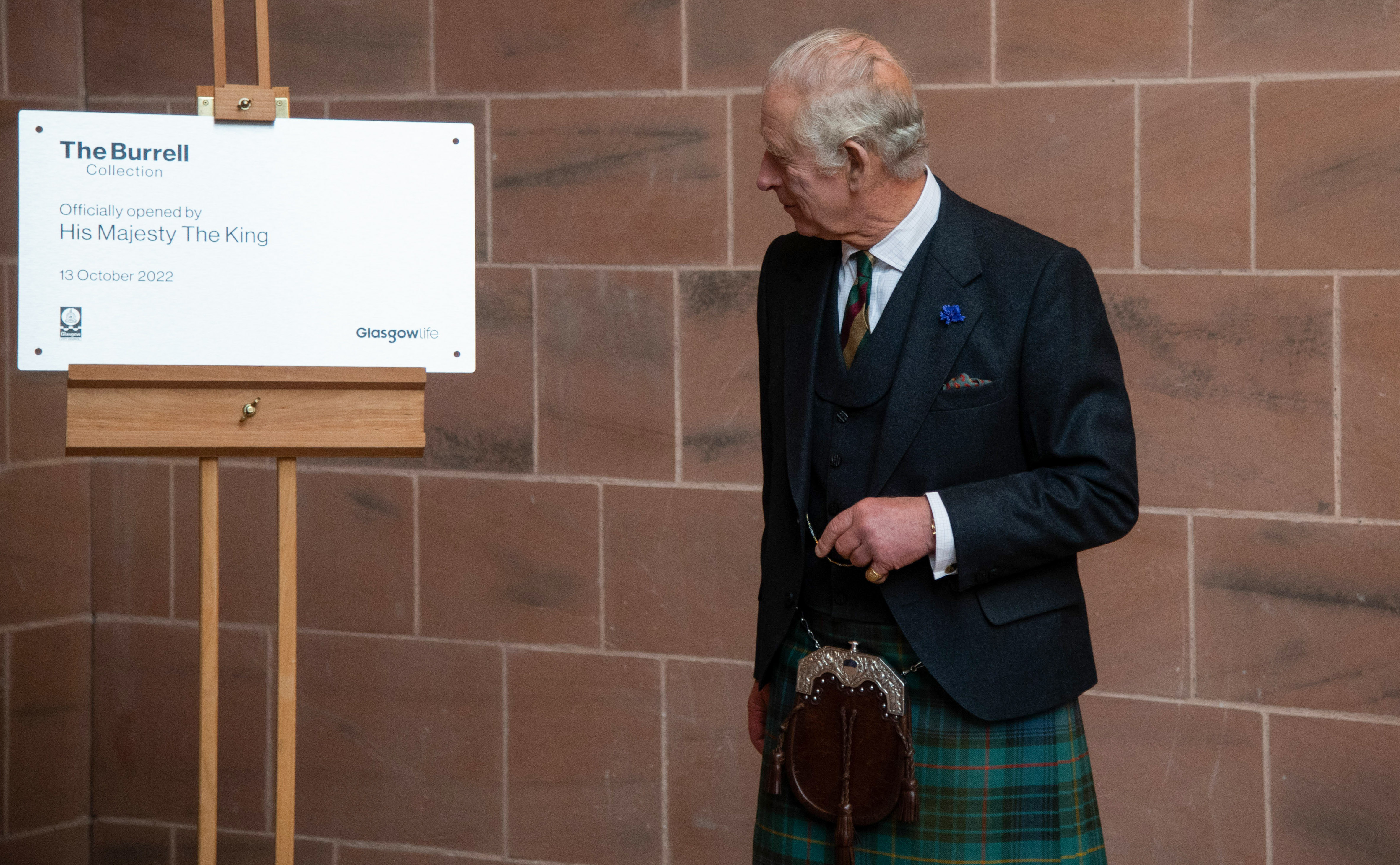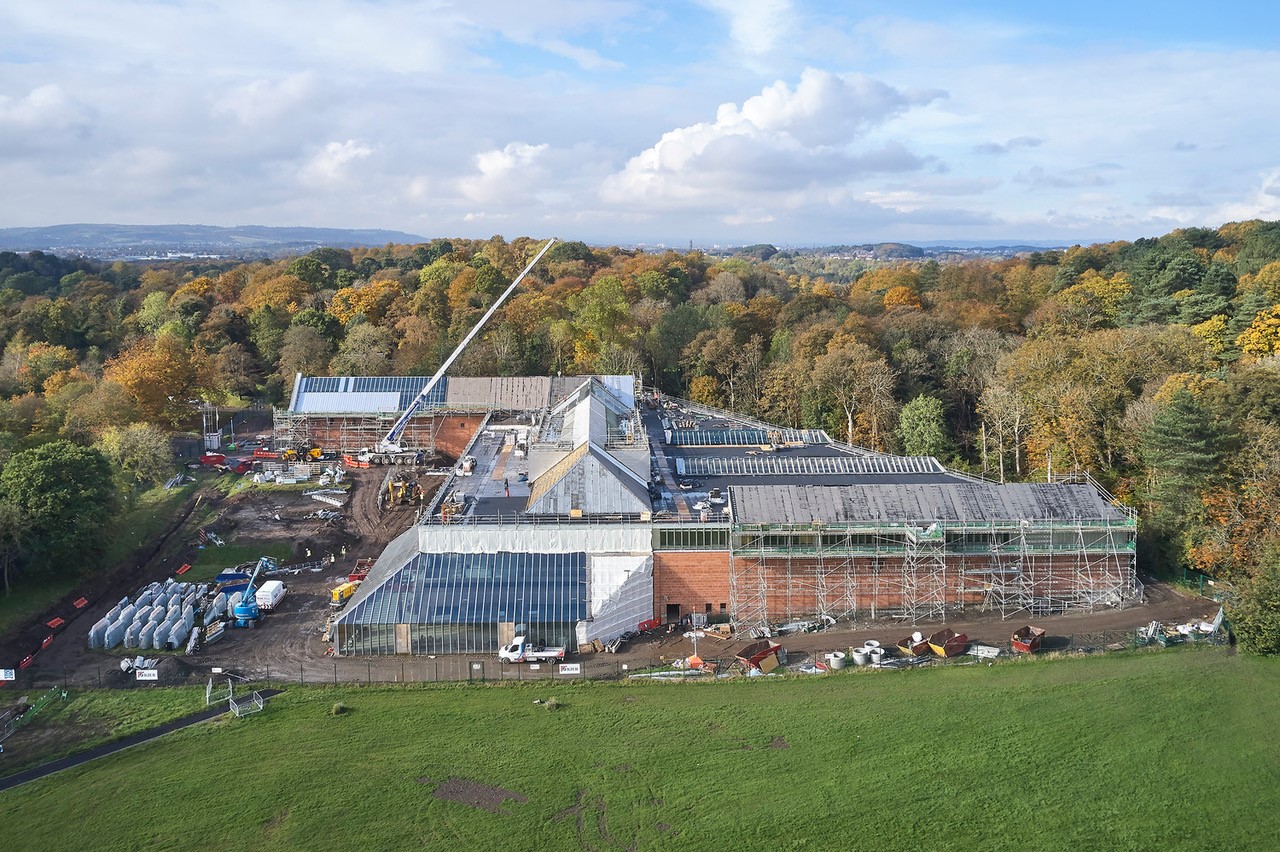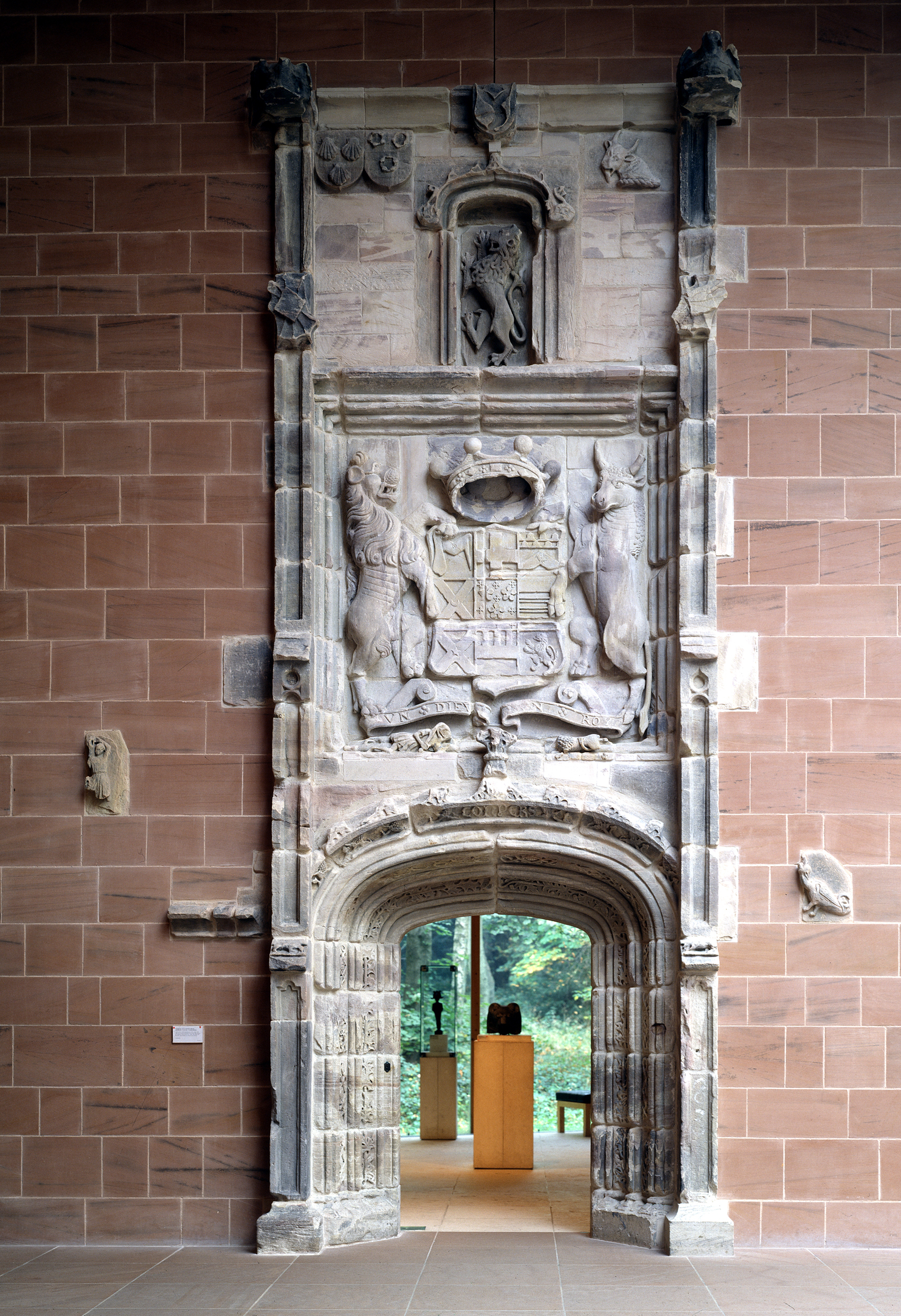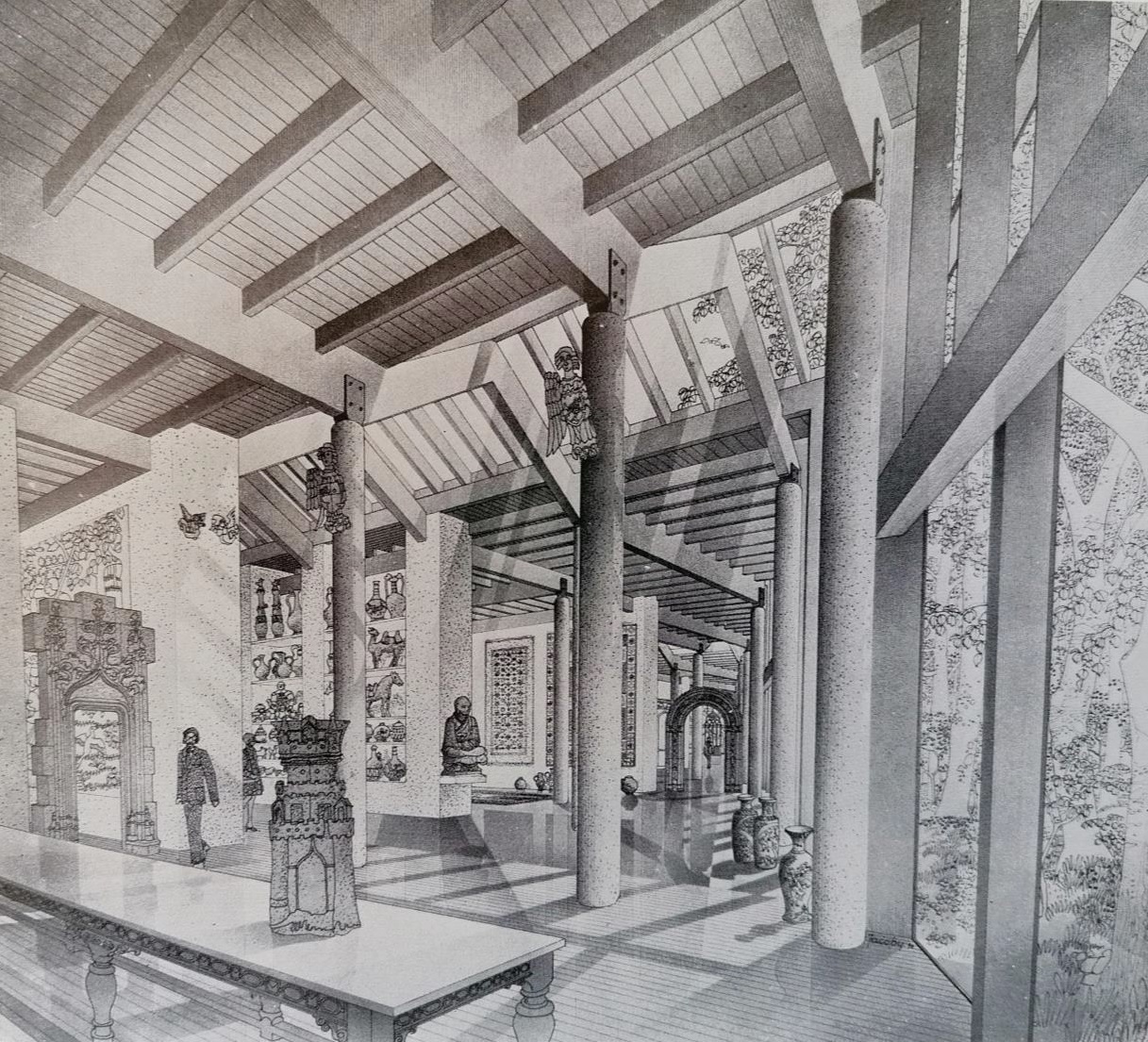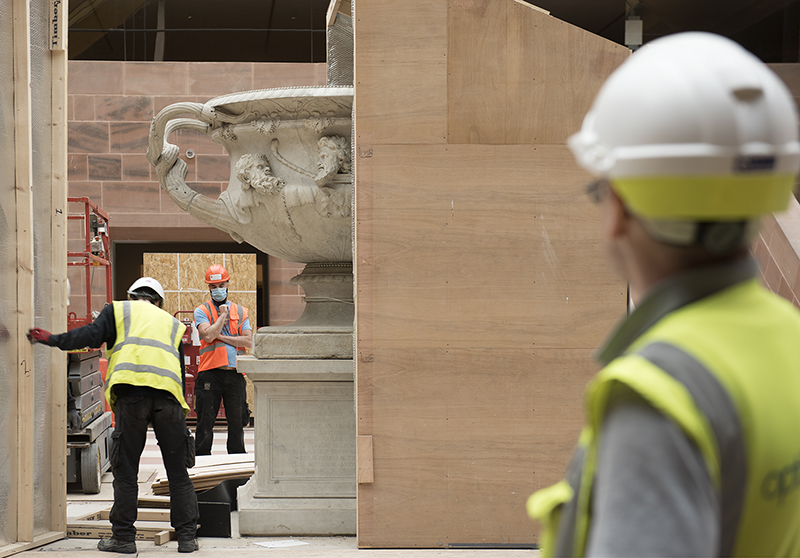The Burrell Collection
Winner of AJ Architecture Award
On 23 of November 2022, The Burrell Collection won the 'culture' category in the AJ Architecture Awards, celebrating the very best in architecture across the UK. The judges described it as: ‘A sophisticated, sensitive, seamless refurbishment,’ praising it as a winning renovation of a much-loved museum, which has revitalised the building without sacrificing its original character.
The Burrell Collection in Glasgow reopened on Tuesday 29 March 2022
The Burrell Collection in Glasgow reopened to the public on Tuesday 29 March after major refurbishment. Nearly half of the funding for the £68.25 million project was committed by Glasgow City Council, with significant contributions from the National Lottery Heritage Fund, the Scottish Government, the UK Government, and from many generous trusts, foundations, grant making bodies, corporate sponsors and individual donors.
Opening date announcement: read more.
Official opening by His Majesty King Charles III
On Thursday 13 October, His Majesty King Charles III officially opened the refurbished Burrell Collection, almost exactly 39 years after Her Majesty Queen Elizabeth II first visited.
Senior Museums Manager, Jane Rowlands gave His Majesty a tour of the new galleries while pupils from several local schools and a nursery who had assisted the project team with some of the object interpretation, helped give a loud royal welcome.
More than 200 Glasgow Life staff, volunteers, project contractors, key stakeholders and community groups joined the special occasion.
This was the King's first official engagement in Glasgow since acceding the throne. Following a viewing of the museum's collection of stained-glass windows and elaborate tapestries, the King unveiled a plaque to mark the official opening of the Burrell Collection.
Awards
On 12 October 2022, The Burrell Collection refurbishment project won Culture and Leisure Project of the Year and Project of the Year at the British Construction Industry Awards: read more
Also on 12 October 2022, the communications strategy for the reopening won Silver for Consumer Relations Campaign at the Chartered Institute of Public Relations Scotland Awards: read more
On 23 November 2022, the refurbishment project won Culture Project and Heritage Project of the Year at the Architects’ Journal Architecture Awards 2022 : read more
Reimagining the Burrell Collection
The Burrell Collection in Glasgow was the UK’s largest and most significant museum refurbishment project of 2021.
About the Collection
Sir William Burrell (1861-1958), owner of a successful shipping company in Glasgow, devoted more than 75 years of his life to amassing this extraordinary Collection.
By the time of his death in 1958, he and his wife Constance, Lady Burrell (1875-1961) had amassed more than 9,000 objects and works of art. The extraordinary richness marks it as one of the world’s greatest, single personal collections.
At the time Sir William and Lady Burrell gifted the Collection to the city in Glasgow in 1944, it amounted to 6,000 objects, with Sir William continuing to add to it right up to his death in 1958. At the time of the original donation, it was described as, “One of the greatest gifts ever made to any city in the world.” (Sir Hector Hetherington, Glasgow University Principal).
Highlights include Chinese pottery and porcelain produced over a 5,000-year period, making it one of the most significant collections of Chinese art in Europe; paintings by renowned French artists including Manet, Cézanne and Degas; Medieval treasures including stained glass, arms and armour, architectural fragrments and over 200 tapestries and carpets, which are among the finest in the world.
The Collection is also home to the Wagner Garden carpet which is one of the three earliest surviving Persian garden carpets in the world, and has rarely been on public display since The Burrell Collection opened. The refurbishment and redisplay means it will be on permanent display accompanied by new and innovative methods of interpretation.
Rationale for the refurbishment
The refurbishment and redisplay represented an important investment in the sustainability of this A-listed building and the Collection. The original building was no longer able to provide a suitable home for the Collection, but a new building would have cost significantly more than the refurbishment: the projected cost for an equivalent sized new build is £100 million +VAT.
Works to the building began in 2018 with repairs to the roof and the installation of modern glazing making the building more air-tight, reducing its overall energy consumption. A combined heating and power supply has also been installed,
A new entrance brings visitors straight into the heart of the building and a newly created central stairway encourages people to explore all three floors of the reimagined museum for the first time. The outdoor green space has also been enhanced, creating new links between the museum and its stunning setting in Pollok Country Park.
The museum’s gallery space has increased by 35%, allowing important and unique objects from the Collection, which have not been seen for decades, or have never been on permanent display, to go on show. New interactive interpretation, including 90 digital displays, give visitors a better understanding of the artworks, the people who made them and some of the people who have owned them.
The original building
The original concept for the building, designed by Barry Gasson, John Meunier and Brit Andresen, was described by Historic Scotland as: “An outstanding bespoke museum commission of international importance, and an important example of Structuralist Tendency in architecture in the second half of the 20th century, emphasising the users' experience and the sense of place, and, in particular, making the most of the interior and exterior interface with the surrounding landscape.”
Culture-led regeneration
The opening of The Burrell in 1983 was one of the first demonstrations of Glasgow’s commitment to cultural-led regeneration. By harnessing the power of its cultural draw, Glasgow positioned itself as one of the world’s great cultural and creative cities, making it a must-visit destination.
The combination of outstanding art and architecture, set within a stunning country park, created something truly special. As the Glasgow Herald reported in 1983 on its opening: "The Burrell is not just a magnificent building, nor is it just an array of precious objects – it’s a magical mystery tour and an aesthetic event rolled into one."
Over 12 million people visited the museum during its first 30 years and there is a strong sense of local pride and ownership of both the Collection and the building.
Since 1980, Glasgow has invested over £1.4 billion on cultural, events and sporting infrastructure. Culture and sport are vitally important to Glasgow economically and socially. Based on Visit Scotland’s average spending figures, Glasgow's museums created direct expenditure in the local Glasgow economy of £168 million in 2015/17. In 2017 it was estimated that the refurbished Burrell Collection would generate at least £1.86 million net economic impact for Glasgow City and £2.97 million for the Clyde Valley area each year.
The success of this approach has been demonstrated by the many accolades the city has been awarded, including:
- European Capital of Culture in 1990
- UK City of Architecture and Design in 1999
- European Commission ‘The UK’s top cultural and creative city’ in 2019
- One of Time Out Magazine's 'Top 10 Best Cities in the World' in 2019
- 'Top Festival and Event Destination' World Travel Awards 2019
- Conde Nast ‘Best UK city break destination’ in 2021
- 1st European City for Openness and Trust, 8th for Vibrancy, European Commission Cultural and Creative Cities Monitor
- 4th on Global Sustainable Index for Business Tourism
- UNESCO City of Music
- In 2023, Glasgow will be European Capital of Sport
Despite financial challenges, the city’s resolve to continue to invest in its cultural estate underlies its emphasis on continuing to improve the lives of its citizens.
The refurbishment transforms The Burrell Collection into an accessible and sustainable museum, designed to preserve and reinvigorate the Collection for future generations.
Refurbishment overview
Architects John McAslan + Partners, appointed in 2016, are the refurbishment project’s architect and landscape designer. John McAslan outlined their response to the brief:
"Responding to the project’s brief has informed our approach across all key areas, starting with essential repairs and upgrades. We have developed alternative ways to access the building to begin the enhanced visitor journey – with an approach which utilises both the existing portal entry and a number of new, discrete additional entrances to increase permeability and connectivity. We have considered how best to integrate the beautifully top-lit courtyard and Hutton Rooms into the visitor experience. In all cases we have respected the original architecture and adjusted it appropriately.
"Additionally, we have introduced energy conservation techniques throughout, whilst reconsidering the power and lighting needs of the Collection to support the improved conservation, interpretation and rotation of the Collection, including the Collection’s needs within the enfilade of north-lit galleries, affectionately known as ‘the walk in the woods’. We have then considered how these galleries might better connect with their southern counterparts and engage more effectively with repurposed internal galleries containing the Collection’s most light-sensitive elements. And, we have resolved how to remove the redundant lecture theatre to create a dramatic internal volume at the heart of the building, connecting each of the Collection’s principal levels – namely, the main gallery floor, a revived lower floor of open access storage, workshops, café and a special exhibition space, and connecting these floors with the repurposed learning spaces on the mezzanine above.
"In the context of enhancing the building’s setting, we are engaging more effectively with the landscape, as an integral part of the visitor experience, whilst reinforcing the Collection at the heart of Pollok Country Park."
Kier Construction Scotland began works in 2018, making the space more accessible for visitors, adding a range of enhanced facilities and carefully restoring and improving parts of the building, including the roof and windows to make it a more energy efficient. Works to the building fabric are designed to make it more airtight, reducing overall energy requirements and contributing to the building’s BREEAM ‘Very Good’ rating.
Funders
National Lottery Heritage Fund
Key building improvements delivered by the refurbishment
Making the building more sustainable:
- All glazing and roof elements have been repaired and replaced. This improvement will see the thermal envelope performance enhanced by approximately 50%. This is critical for a museum due to the stringent space conditioning demands internally.
- The fabric has been further improved by enhancing air tightness, which will reduce energy consumption.
- The existing services, including heating, ventilation and lighting are mostly still served by the original plant. Improvements in technology have enhanced the energy performance of key central plant items such as air handling units, boilers, pump sets and lighting controls and as such, all plant and mechanical and electrical services within the building have been replaced.
- All new air handling units have electronically communicated (EC) motor technology. The ventilation strategy itself is based on a demand approach, allowing the air handlers to slow down, and in cases switch off, when air treatment is not required. This as and when needed approach helps control energy demands.
- Variable flow chilled and hot water distribution helps deliver water for heating and cooling as and when needed. This approach allows energy to be saved in pumping systems. As with the air handling, chilled and hot water is only sent when required, saving energy through control and pipework heat loss.
- New chillers with heat recovery have been implemented, providing a degree of space heating through reclaiming waste heat that would otherwise be disposed of in the atmosphere.
- Heat is also being recovered from hot plant rooms and sent to the undercroft of the building. This is particularly advantageous to the café space, which has a large exposed floor slab. This technique enables air removed from warm plant zones to act as a layer of insulation to the building’s concrete floor in winter.
- A high degree of metering improves understanding of where energy is being used, giving the facilities management team a better idea where energy could be saved.
- A fresh water heating and cooling system is also being used. Recent studies have indicated that pipework for heating services can lose around 20% of the heating energy through poor quality insulation. Pipework routes have been reduced and new high performance phenolic foam insulation conserves as much of the distributed energy as possible. The variable flow distribution systems also limit the quantity of water being distributed and exposed to potential heat loss.
- New low energy lighting systems and improved controls have been installed, giving greater control over all fittings, with energy savings expected on both the installed load and through greater control flexibility.
Reaching new standards in sustainability at The Burrell Collection: read more
Making the building more accessible:
- With responsibility to care for the Collection and deliver on the terms of the Deed of Gift, including stipulations on how and where the Collection should be housed, Glasgow Life must also ensure it is accessible to the people of Glasgow and visitors to the city.
- A new 1000sq m accessible concourse has been built, linking the main entrances with the car park and bus/coach stop.
- A new accessible path links the existing play park to the new café terrace and a new collections themed playscape is planned for early years children directly outside the museum.
- Inside, two changing places toilets have been installed, with accessible lifts providing access to all levels of the building.
Consultation programme
Since The Burrell Collection closed to the public in October 2016, a comprehensive consultation programme engaged with more than 15,000 local people, who gave ideas, insights and opinions which have shaped every aspect of the redesign of the building, access to it and the development of the new displays, galleries and spaces within and around the museum.
From the start of the refurbishment project, the opinions and aspirations of local people has been instrumental in the redesign of all aspects of the museum. Gaining an understanding of why people came to the museum and why others didn’t, together with what new visitors would like to see, helped inform every decision.
Since 2012 the most comprehensive outreach programme ever undertaken by Glasgow Life has established new links between thousands of people living near The Burrell Collection and Pollok Country Park. This has shaped the redesign of the building, access to it and the development of the new displays.
Interviews, focus groups, surveys, prototype testing and work with a range of Glasgow Museums Advisory Panels led to engagement with over 15,000 people, from across Glasgow and beyond. Feedback from existing and potential new visitors, across adult, family and early years audiences has been gathered and acted upon.
The Visitor Studies team have:
- Conducted or commissioned over 100 individual pieces of research on the Burrell Collection. These include everything from visitors’ understanding of gallery titles to the accessibility of toilets.
- Participated in more than 2,300 hours of face-to-face contact, a figure which will grow as opening approaches.
- Undertaken research and consultation in over 20 Glasgow venues, including Kelvingrove Art Gallery and Museum, Langside Library, The Nan McKay Community Centre and Pollok Country Park.
- Hosted 14 meetings of the Glasgow Museums Access Advisory Panel that have specifically focused on Burrell Collection Refurbishment Project topics. The Glasgow Museums Access Advisory Panel currently comprises of representatives from 19 charities and organisations, which represent people who often experience barriers to visiting museums, to ensure the redesigned museum is accessible to all.
- As a result of 170 sessions, totalling 400 hours with 320 community partners, three new displays have been created at Pollok Civic Realm Community Centre in collaboration with groups within a 3-mile radius of Pollok Country Park.
- Created three new Burrell Collection handling boxes in collaboration with local community groups; Southside Housing Association Smiley Saturdays, AMINA Muslim Women’s Resource Centre and Pollok Children’s Nursery.
Comments on the refurbishment project at the time of opening
Councillor David McDonald, Chair of Glasgow Life, and Depute Leader of Glasgow City Council, said: “It’s wonderful to see that the installation of Sir William’s precious, beautiful and intriguing Collection has begun, now the delicate refurbishment of its home is almost at an end.
“This major refurbishment and redisplay will celebrate Sir William’s outstanding gift to the city and ensures it is at the heart of Glasgow’s cultural identity for the future, and having much more of The Collection on display and accessible will be one of its immediate successes.
“Sir William’s incredible legacy will help Glasgow and Scotland’s recovery from Covid-19, bringing increased pride and confidence, which has a tangible effect on our wellbeing. As we move out of a pandemic that is vital.”
Chief Executive of Glasgow Life, Dr Bridget McConnell, CBE, said: “March 2022 will mark a historic milestone in Glasgow’s story, as the completely refurbished Burrell Collection reopens to the world.
“Very soon, thanks to all the project’s funders, these wonderful works of art, which Sir William Burrell gave to the people of Glasgow, will be enjoyed in a modern, green museum, fit for purpose and for the future.
“Our vision for The Burrell Collection demonstrates the city’s ambition for it to become more widely appreciated and well known around the world and for Glasgow to retain its place as a global cultural leader.”
Sir Angus Grossart, Chair of Burrell Renaissance, said: “The Burrell Collection has a reputation as being one of the finest in the world. The wonderful new displays have enhanced and informed what visitors will see. They will find great cultural diversity, much
beauty and wonder and the great achievement of one enquiring and questioning mind, that of Sir William Burrell.”
Caroline Clark, Director Scotland, the National Lottery Heritage Fund, said: “It is very exciting to think of the Burrell’s doors re-opening on this incredible art collection.
“Our major award of £16.5m was given in recognition not only of the importance of the Burrell’s stunning collection and architecture, but also because of the creative and inclusive design approach taken by Glasgow Life, with over 15,000 people sharing their ideas and collectively helping to create the new displays. We should applaud the effort of each and every one of these people as we celebrate the news that this much-loved cultural icon will be re-opening this coming March.”
The Scottish Government Culture Minister, Jenny Gilruth, said: “I am pleased that one of the great cultural destinations in Scotland, Glasgow’s Burrell Collection, will be re-opening next year after a significant refurbishment.
“Supported by £5.75 million in Scottish Government funding, this ambitious project will ensure the building is not only modernised and made more energy efficient, but will be more accessible to the public for years to come, and with a greatly expanded exhibition space.
“I’m particularly delighted that the redesign has been achieved in consultation with more than 15,000 people, ensuring that the citizens of Glasgow have had a say in its rebirth.
“As we recover from the pandemic, this reopening of this nationally important museum is a reminder of how important culture is to all our lives.”
UK Government Minister for Scotland Iain Stewart said: “The UK Government’s £5 million investment into The Burrell Collection’s sustainable refurbishment and redisplay will help ensure the people of Glasgow, as well as visitors from across the UK and around the world, can enjoy this unique art collection for generations to come.
“With other recent investments in Scotland including a £97m allocation from our Culture Recovery Fund, £1m for the Edinburgh Festivals, and £10m to support the development of the Dunard Centre, the UK Government is committed to supporting Scotland’s world-class arts and culture sector as we recover from the pandemic together.”
Professor Frances Fowle, Senior Trustee, Sir William Burrell Trust, said: “This exciting new refurbishment will once again provide a first-class setting for our world-class Collection. The innovative new displays, including a unique open storage facility, bring to life not only Sir William and Lady Burrell as collectors, but also the objects that they cherished. The Trustees are proud to support such an important project, creating new opportunities for visitors, both local and international, to appreciate the beauty and diversity of this outstanding collection.
Refurbishment team
Main building and design consultants
- John McAslan & Partners – Architect
- Gardiner & Theobald – Project Manager + Cost Consultant + Principal Designer
- Atelier Ten – MEP Engineer + Fire Engineer + BREEAM Consultant
- David Narro Associates – Structural Engineer
- Arup Facades – Façade Engineer
- Sandy Brown Associates – Acoustic Consultant
- Event Communications – Exhibition Designers
- JoH Design Ltd – Foodservice Design Consultants
Other contractors and manufacturers
- Kier Construction Scotland – Main Building Contractor
- Beck Interiors – Main Exhibition Contractor
- Meyvaert – Display Case Contractor
- All Star Joinery
- Aivaf
- Ballicom International Ltd
- Boyd-Thorpe Associates
- Burnfield Demolition
- D J Willrich Ltd
- Elmwood Projects Ltd
- Graciella Ainsworth Sculpture Conservation
- GV MultiMedia Ltd
- The ISO Organisation Ltd
- Leach Colour Ltd
- Lumsden Design
- Peter Brett Associates
- Tactile Studio
- The Scottish Glass Studio
- The Seeking State
- StudioLR
- Squint Opera Ltd
- The Textile Conservancy Company
- Orbis Conservation Limited
Timeline
| 1944 | Sir William Burrell and Constance, Lady Burrell gift their collection of 9,000 works of art to the City of Glasgow |
| 1967 | Pollok Country Park is gifted to the city by the Stirling-Maxwell family, whose ancestral home was Pollok House |
| 1969 | Sir William Burrell Trust agree to proposal for a purpose-built home for the Collection to be constructed in Pollok Country Park |
| 1971 | International competition launches to design a home for the Collection, to meet the terms of the Deed of Gift set by Sir William Burrell (1861-1958) |
| 1972 | Winning architectural team announced: Barry Gasson, John Meunier and Brit Andresen |
| 1978 | Construction works begin on site |
| 1983 | The Burrell Collection is officially opened on 21 October by Her Majesty The Queen |
| 1984 | The museum welcomes over 1 million visitors in its first year of opening |
| 1990 | Glasgow is European City of Culture |
| 1999 | Glasgow is UK City of Architecture and Design |
| The Burrell Collection is widely recognised as having helped bring both of these accolades to the city, acting as a catalyst for Glasgow’s transformation into a cultural powerhouse | |
| 2013 | The Burrell Collection is designated a Grade A listed building, acknowledging its significance |
| 2014 | Community consultation process begins involving 15,000 local people in order to make the art works relevant for current and future generations |
| 2015 | Selected works of art begin an international tour of France, North America and Japan as well as the UK |
| 2016 | The Burrell closes to the public for a major refurbishment and redisplay |
| 2016 | John McAslan + Partners appointed as architect for the refurbishment and redisplay |
| 2017 | Kier Construction Scotland appointed as main contractor |
| 2018 | Construction works begin on site |
| 2018 | A series of temporary exhibitions begins at Kelvingrove Art Gallery and Museum featuring works by artist Joseph Crawhall (1861-1913) and highlights of the Medieval and Chinese collections |
Transforming Pollok Country Park
The Burrell Collection sits within Pollok Country Park. This is Glasgow’s largest country park (360-acres) and is located in the south west of the city. Attracting 2 million visits a year, its extensive woodlands and gardens provide a quiet sanctuary from the nearby city centre.
As well as its importance as a green space for leisure and nature conservation and a contributor to Glasgow’s Climate Implementation Plan, Pollok Country Park has outstanding heritage features, including the Burrell Collection and Pollok House, two of Scotland’s most important museums, both of which are Category A Listed buildings.
Alongside the refurbishment of the Burrell Collection and significant investment in Pollok House, Glasgow City Council and Glasgow Life are delivering ‘The Transforming Pollok Country Park Project’. This aims to transform the country park from a wonderful but underutilised historic space, into a world class civic destination enjoyed more often by citizens and visitors to the city.
The project aims to improve access to the park and its attractions by:
- Promoting and enhancing sustainable and active travel routes.
- Providing an electric shuttle bus infrastructure, encouraging less reliance on private vehicles to travel to and through the park.
- Delivering electric vehicle charging points to promote sustainable transport for visitors and local residents.
- Providing an improved park entrance and car park to help manage vehicular traffic.
A number of improvements are possible with support from a £1.56m award from Transport Scotland and European Regional Development Funding, via the Low Carbon Travel and Transport Challenge Fund to deliver a Low Carbon and Active Travel Hub at Pollok Country Park.
Visitors are now benefitting from:
- 2.34 km of new or upgraded path and cycle networks.
- An improved visitor entrance at Pollokshaws Road.
- The installation of 23 electric vehicle chargers in the Burrell Collection car park and the installation of an associated Battery Energy Storage System at the Burrell Collection ( to be completed by end of 2022).
- The provision of bus stop lay-bys and shelters to support the electric park shuttle service.
- Access to new cycle shelters throughout the park.
- Access to a fleet of e-bikes for park visitors, cycle hire storage and workshops.
Media coverage of the opening date announcement
- The Times 21 August 2021 Must-visit museums where you can wander and wonder
- The Herald 12 August 2021 Using culture to build a city's economy
- BBC News 03 September 2021 Reopening plans
- The Herald 03 September 2021 Reopening plans
- The Scotsman 03 September 2021 Reopening plans
- The Sunday Post 03 September 2021 Reopening plans
- STV News 03 September 2021 Reopening plans
- The Times 03 September 2021 Reopening plans
- The National 03 September 2021 Reopening plans
- Evening Telegraph 03 September 2021 Reopening plans
- Insider 03 September 2021 Reopening plans
- Project Scot 03 September 2021 Reopening plans
- Forbes Alert 03 September 2021 Reopening plans
- NY Press News 03 September 2021 Reopening plans
- News Nation USA 03 September 2021 Reopening plans
- Scottish Construction Now 03 September 2021 Reopening plans
- McAslan + Partners blog 10 November 2021 Sustainability standards
Further information
--Glasgow Life 16:39, 31 Aug 2021 (BST)
Related articles on Designing Buildings
IHBC NewsBlog
Old Sarum fire in listed (& disputed) WW1 Hangar - Wiltshire Council has sought legal advice after fire engulfed a listed First World War hangar that was embroiled in a lengthy planning dispute.
UK Antarctic Heritage Trust launches ‘Virtual Visit’ website area
The Trust calls on people to 'Immerse yourself in our heritage – Making Antarctica Accessible'
Southend Council pledge to force Kursaal owners to maintain building
The Council has pledged to use ‘every tool in the toolbox’ if urgent repairs are not carried out.
HE’s Research Magazine publishes a major study of the heritage of England’s suburbs
The article traces the long evolution of an internal programme to research 200 years of suburban growth
IHBC Context 183 Wellbeing and Heritage published
The issue explores issues at the intersection of heritage and wellbeing.
SAVE celebrates 50 years of campaigning 1975-2025
SAVE Britain’s Heritage has announced events across the country to celebrate bringing new life to remarkable buildings.
IHBC Annual School 2025 - Shrewsbury 12-14 June
Themed Heritage in Context – Value: Plan: Change, join in-person or online.
200th Anniversary Celebration of the Modern Railway Planned
The Stockton & Darlington Railway opened on September 27, 1825.
Competence Framework Launched for Sustainability in the Built Environment
The Construction Industry Council (CIC) and the Edge have jointly published the framework.
Historic England Launches Wellbeing Strategy for Heritage
Whether through visiting, volunteering, learning or creative practice, engaging with heritage can strengthen confidence, resilience, hope and social connections.






